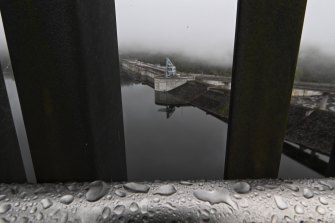
Warragamba Dam recorded its fourth-highest ever monthly storage level as bursts of record rainfall pelted Sydney in July, reflecting the scale of recent rainfall across Sydney.
For almost two years now, Warragamba Dam has been full following a period of declining storage from March 2017 to January 2020 when the dam reached 40 per cent capacity and another big east coast low hit the city.
Since it was completed in 1960, the dam has spilled about 50 times, with the highest storage peaks in 1961, followed by 1964, 1990 and July 2022. There was a long stretch between spills from August 1998 to March 2012.
The dam dropped to its lowest level ever during the millennium drought in February 2007 when reserves hit 32.5 per cent of capacity, forcing water transfers from other dams. During the drought a volume equivalent to almost 30 per cent of greater Sydney’s water came from Tallowa Dam.

Warragamba Dam has been at or close to capacity for months. Credit:Nick Moir
Recent rainfall due to an east coast low hit a much smaller area than the February-March conditions that lasted three weeks soaking about 35 separate catchments, said Dr Tom Mortlock, senior analyst at insurance company Aon and an adjunct fellow at Macquarie University,
“North Richmond and Windsor on the Hawkesbury River this time around both reached 14 metres, which was the same as the peak on March 9,” Mortlock said. “The Nepean at Penrith reached just under 10 metres (the major flood level) this time and there was no major flooding on the Nepean in March.”
Wollondilly Mayor Matt Gould said the major floods that impacted his shire and Camden this week exceeded 16 metres in some places and none of that water is captured by Warragamba Dam.









 Add Category
Add Category